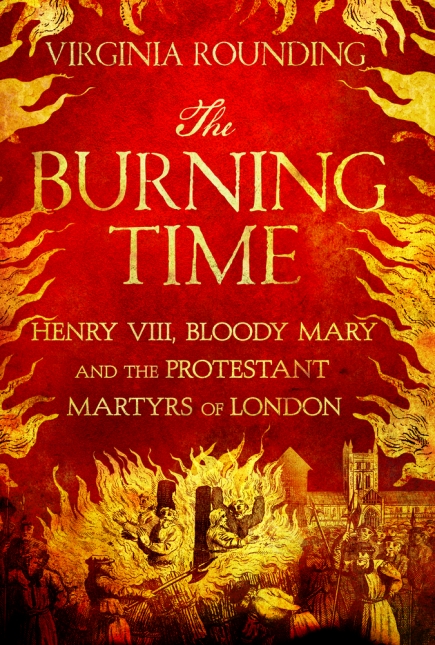The Burning Time: Henry VIII, Bloody Mary and the Protestant Martyrs of London
- By Virginia Rounding
- St. Martin’s Press
- 480 pp.
- Reviewed by Bob Duffy
- November 9, 2017
An authoritative chronicle of the gruesome era when religious dissenters met their end at the stake.

In this hefty volume, historian Virginia Rounding zeroes in on a slice of English reformation history rarely covered in a book earmarked for the general reader. Rounding’s previous work centers on Russian imperial biography and French courtesans, but here she examines the brief period during which a trio of successive Tudor monarchs turn to a grisly strain of capital punishment to quash religious dissent. The Burning Time centers on burnings at the stake, beginning with early instances under Henry VIII and culminating horridly during the reign of Mary I, which ended with her death in 1558.
Rounding presents this chronicle with authority and admirable, if occasionally distasteful, attention to detail. She relies consistently on contemporary records, not just secondary commentaries from modern times. The Burning Time opens two decades or so into the regime of Henry VIII. Henry authorized fewer than a score of burnings during his reign, although scholars charge him with thousands of political and religious executions via other means.
Henry was succeeded in 1546 by his 9-year-old son, Edward VI, whom his circle of advisors had molded into a rigid Protestant (which Henry — at his core — was not). Burnings spiked during Edward’s reign, which ended with his death at 16. Then along comes Mary, daughter of King Henry and his first wife, Katherine of Aragon.
A militant Catholic, Mary I intends to restore the kingdom to the religious authority of the pope; she pushes forward a regime of civic immolation targeting the most visible resisters. Mary Tudor ultimately sends nearly 300 victims to the stake. Even her husband and royal consort, Philip II of Spain, roundly despised in England as a vector of foreign-smelling papist influences, is said to have urged Mary to tamp down her zeal for putting reformers to the torch.
Rounding’s saga winds down in 1558, as Mary’s half-sister, Elizabeth I, ascends to the throne. Our author leaves off here, perhaps because the Virgin Queen mostly abjures the burning solution, even as she reverses Mary’s religious policies and restores the Church of England.
As history tells us, Elizabeth’s difficulties with the lingering Catholic resistance mainly turn out to be dynastic rather than doctrinal. One example: Jesuit infiltrators from the continent are fomenting revolution from “hidey-holes” in Catholic manor houses. Meanwhile, Elizabeth’s militant Catholic cousin Mary, Queen of Scots — an unwilling “houseguest” of a lord loyal to Elizabeth — is pacing the parapets, ever vigilant for rescue by the rebels and installation as the rightful monarch. Elizabeth ultimately has her beheaded.
In The Burning Time, Rounding proves a thorough chronicler of the relatively short span of years she stakes out for examination. For instance, she succinctly illuminates the distinctions of doctrine and sacramental practice dividing traditional Catholics from reforming Protestants (e.g., for Catholics, there are seven sacraments; for the reformers, just two).
The old religionists also look to the Greek and Latin versions of the Bible — ever subject, of course, to priestly interpretation — as the sole authoritative scriptures, versus the English-language bible and liturgy that Protestant congregants use. For papists, faith and good works are the dual pathways to salvation, while faith alone (“sola fides”) does the trick for the reformers.
Compelling characters pop up regularly in this saga. Take the wily Thomas Cranmer, whom King Henry had appointed Archbishop of Canterbury in 1532. Cranmer was a key advisor to Henry VIII through the final 15 years of his reign. As it turns out, the archbishop had stashed a wife and kids in France, a closely held secret (at least from the monarch).
Despite his own connubial adventurism, the king remained staunchly opposed to priestly marriage. This ceased to be a problem when King Edward came on the scene. Cranmer installed his French ménage in his Canterbury mansion, until the new Catholic queen rode into town, ablaze with doctrinal zeal, to set such practices right. Cranmer, defrocked and convicted of heresy in 1553, went to the flames.
And consider Richard Rich, whose report of a private conversation with the circumspect lawyer Thomas More — likely embellished if not baldly fraudulent — sealed the deal that sent More to the scaffold to be beheaded. Rich, named a baron in Henry’s will and later appointed Lord Chancellor under Edward, has to be one of the great survivors in English history, as he returned to the Romish fold under Mary and eventually died of natural causes in 1567.
For the scholar, the last third of Rounding’s book, where she recounts the individual stories of many of the Marian martyrs, is likely the most illuminating segment. Here the author builds on contemporary records from the Smithfield district of London, where most of the burnings took place (and where she lives today). On the other hand, for the non-academic reader, this section might seem superfluously granular, even though it showcases Rounding’s skills as a vivid storyteller.
In whatever way you approach this book, you will find much informed commentary, often supplemented with extended digressions, like Rounding’s long summary of attitudes toward martyrdom throughout Christian history, as well as among non-European cultures, notably Islam. If this review whets your interest, the best way to tackle The Burning Time might be selectively — i.e., index-driven and sampled — rather than consumed in all its arcane detail.
Former academic Bob Duffy is a Maryland writer and consultant in advertising and branding.

